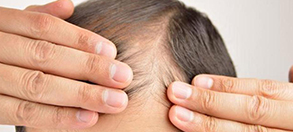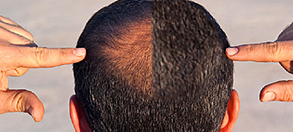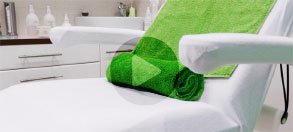Vitamins and supplements are natural treatment options for those who experience thinning or balding hair. Turning to natural remedies is often the first step to reclaiming a healthy hairline. While they might incite hair growth, these vitamins and supplements do not benefit everyone equally. But, for those who have noticed thinning or balding hair, turning to these vitamin and mineral supplements might be a beneficial first step before exploring hair transplantation options with NeoGraft or ATERA technologies. If you are interested in reclaiming your hairline and preserving your luscious locks, don’t hesitate to schedule a consultation at our Houston offices. Our trained, hair restoration consultant and Dr. Jezic will discuss treatment options and determine if hair transplants are your next step, or if you might see improvement with a carefully designed regimen of supplements. Call our offices at (713) 864-2300 to schedule a consultation or fill out this online form and one of our staff members will be in contact with you shortly.
Are You Losing Your Hair?
pot hair loss, there are easier tests that are more reliable. One test is to look at a picture of yourself from years ago. Does your hair look thicker or fuller than it does now? Did your hairline extend further forward on your head? Another test is to grab a hold of around 60 hairs. Lightly pull. If you count six or more loose hairs in your hand, then you might be experiencing hair loss. The best test, however, is to see a hair loss specialist.
About Natural Hair Loss
Androgenetic alopecia, the most common form of alopecia, is pattern baldness that commonly affects 50% of women and 80% of men during their lifetime.[1] Women’s crowns most notably start to thin later in life, around the time of menopause. Men, however, can see pattern baldness much earlier. In fact, 25% of men with androgenetic alopecia start to see their hair thin by the time they’re 21 years old.[2] This condition is caused by androgen-sensitive hair follicles coming into prolonged contact with testosterone. Typically, menopausal women see a shift in their estrogen levels, causing an imbalance with their testosterone levels. With an uptick in testosterone levels, women oftentimes see their hair grow thinner and more brittle. Likewise, men’s testosterone levels peak around their mid-twenties and early thirties. It is no wonder that by the time men reach 50 years old, 30-50% of them have some degree of thinning or balding in their hair.[3] To treat this condition, many turn to natural vitamins and supplements to provide potent nutrients to aid in regrowing a thick head of hair. But it’s not always hormones that are to blame. Our body relies on a variety of vitamins and minerals to maintain follicular health. For some, identifying deficiencies and taking the proper supplements can lead to significant improvements in the thickness and density of hair.
Zinc
Found mostly in fish and meat, zinc is not readily produced in the body and must be supplied through diet. Zinc is an essential contributor to multiple enzymes and is heavily involved in inhibiting follicle regression and accelerating follicles’ recovery.[7] Many different studies have established zinc deficiency as a cause for alopecia and have shown that proper zinc supplementation can reverse hair loss.
Biotin
Though many B vitamins can aid different conditions, biotin is the go-to B vitamin for hair growth. Formally known as vitamin B7, biotin is the only B vitamin produced by the body, which means it’s actually very rare to find someone with a biotin deficiency.[4] Foods like nuts, legumes, whole grains, rice, and egg yolk have sufficient levels of biotin. Inside the body, biotin plays an important role in protein synthesis and keratin production, where it contributes the necessary properties for healthy hair and nail growth. When biotin levels are higher, the necessary nutrients can produce more potent keratin, leading to stronger nails and thicker hair.
Iron
Iron deficiency is the most common nutritional deficiency in the world and often leads to lethargy, diminished cognitive performance, decreased resistance to infection, and non-hereditary hair loss.[5][6] Our body uses iron to make new red blood cells and stores its iron supply inside cells called ferritin. When ferritin levels are low, doctors can deduce that the patient is iron deficient. With less iron in the body, red blood cells have a harder time transporting oxygen around the body, so the body uses the ferritin stored in hair follicles to make up for the deficiency. As the body strips the hair follicles of their nutrients, the patient’s hair grows thinner and weaker.
Vitamin D
Vitamin D is a vitamin as well as a hormone that plays a vital role in our body’s physiological functions because of its anti-inflammatory and immune-regulating properties. This essential vitamin also plays a role in protecting muscle and bone health. Research has shown that vitamin D plays an intrinsic role in various signaling pathways of growth and differentiation of hair follicles.[8] Furthermore, vitamin D deficiency has been linked to cases of androgenetic alopecia.
Candidates
While supplementation with different vitamins and minerals may be beneficial for some patients, they typically only aid those with non-hereditary alopecia. Also, vitamins and supplements help preserve hair and improve hair health, they may not necessarily grow hair or restore lost hair. With age, our body’s systems are unable to maintain their youthful vigor. Unfortunately, this reality is also true with our hair follicles. So, for those who have found minimal effects by supplementing with one or more of the aforementioned vitamins, we invite you to schedule a personal consultation at our Houston offices. Hair loss can affect anyone at any age, so there’s no set age limit for hair transplants. We do ask patients who smoke or take blood-thinning medications to stop a couple of weeks before their procedure and for their entire recovery.
Personal Consultation
At Houston Hair Transplant Center, we are committed to bringing our clients the best results possible, all the while using the most advanced techniques and technologies. If this is your first appointment with us, we will start with a brief new patient intake interview and a physical examination. We will note the state of your hair loss and discuss any concerns you may have about your hair. Then, Dr. Goran Jezic, the physician at Houston Hair Transplant Center, will construct a comprehensive treatment plan to achieve your hair growth goals.
Your Treatment Options
We offer two different technologies that utilize follicular unit extraction (FUE). The process of FUE involves extracting healthy hair follicles from donor areas around the sides and back of the head. These follicles are prepared to be relocated to balding or thinning areas around the head. Unlike other hair transplantation techniques, FUE produces minimal scarring. Typically, patients see results after a couple of weeks as the relocated hair follicles transition into the active growth stage. Over time, these follicles grow hair in these thinning and balding areas, which produces an all-around fuller head of hair for the patient. We offer both ATERA and NeoGraft, two highly effective FUE technologies. Both leave no linear scars and both produce remarkable results. The difference between the two is that ATERA uses lubrication and separate suction to target donor areas. The ATERA is more automated and faster whereas NeoGraft is manually performed by a trained specialist. Dr. Jezic will help you decide which approach is best for you and your desired results.
How Much Do Hair Transplants Cost In Houston?
The cost of your treatment will depend on the state of your hair loss and the extent of your procedure. We will determine the cost of your treatment during your consultation. For those receiving NeoGraft, check out our page on the cost of NeoGraft. For those receiving ATERA, check out the ATERA costs here. To stay up to date on all things going on at Houston Hair Transplant Center, be sure to read out blogs!
References
- Piraccini BM;Alessandrini A. (2014). Androgenetic alopecia. Giornale Italiano Di Dermatologia E Venereologia : Organo Ufficiale, Societa Italiana Di Dermatologia E Sifilografia, 149(1). https://pubmed.ncbi.nlm.nih.gov/24566563/
- American Hair Loss Association – Men’s Hair Loss / Introduction. (2021). Americanhairloss.org. https://www.americanhairloss.org/men_hair_loss/introduction.html
- Cranwell W, Sinclair R. Male Androgenetic Alopecia. [Updated 2016 Feb 29]. In: Feingold KR, Anawalt B, Boyce A, et al., editors. Endotext [Internet]. South Dartmouth (MA): MDText.com, Inc.; 2000-. Available from: https://www.ncbi.nlm.nih.gov/books/NBK278957/
- Almohanna, H. M., Ahmed, A. A., Tsatalis, J. P., & Tosti, A. (2019). The Role of Vitamins and Minerals in Hair Loss: A Review. Dermatology and therapy, 9(1), 51–70. https://doi.org/10.1007/s13555-018-0278-6
- Trost, L. B., Bergfeld, W. F., & Calogeras, E. (2006). The diagnosis and treatment of iron deficiency and its potential relationship to hair loss. Journal of the American Academy of Dermatology, 54(5), 824–844. https://doi.org/10.1016/j.jaad.2005.11.1104
- Park, S. Y., Na, S. Y., Kim, J. H., Cho, S., & Lee, J. H. (2013). Iron plays a certain role in patterned hair loss. Journal of Korean medical science, 28(6), 934–938. https://doi.org/10.3346/jkms.2013.28.6.934
- Park, H., Kim, C. W., Kim, S. S., & Park, C. W. (2009). The therapeutic effect and the changed serum zinc level after zinc supplementation in alopecia areata patients who had a low serum zinc level. Annals of dermatology, 21(2), 142–146. https://doi.org/10.5021/ad.2009.21.2.142
- Saini, K., & Mysore, V. (2021). Role of vitamin D in hair loss: A short review. Journal of cosmetic dermatology, 20(11), 3407–3414. https://doi.org/10.1111/jocd.14421




